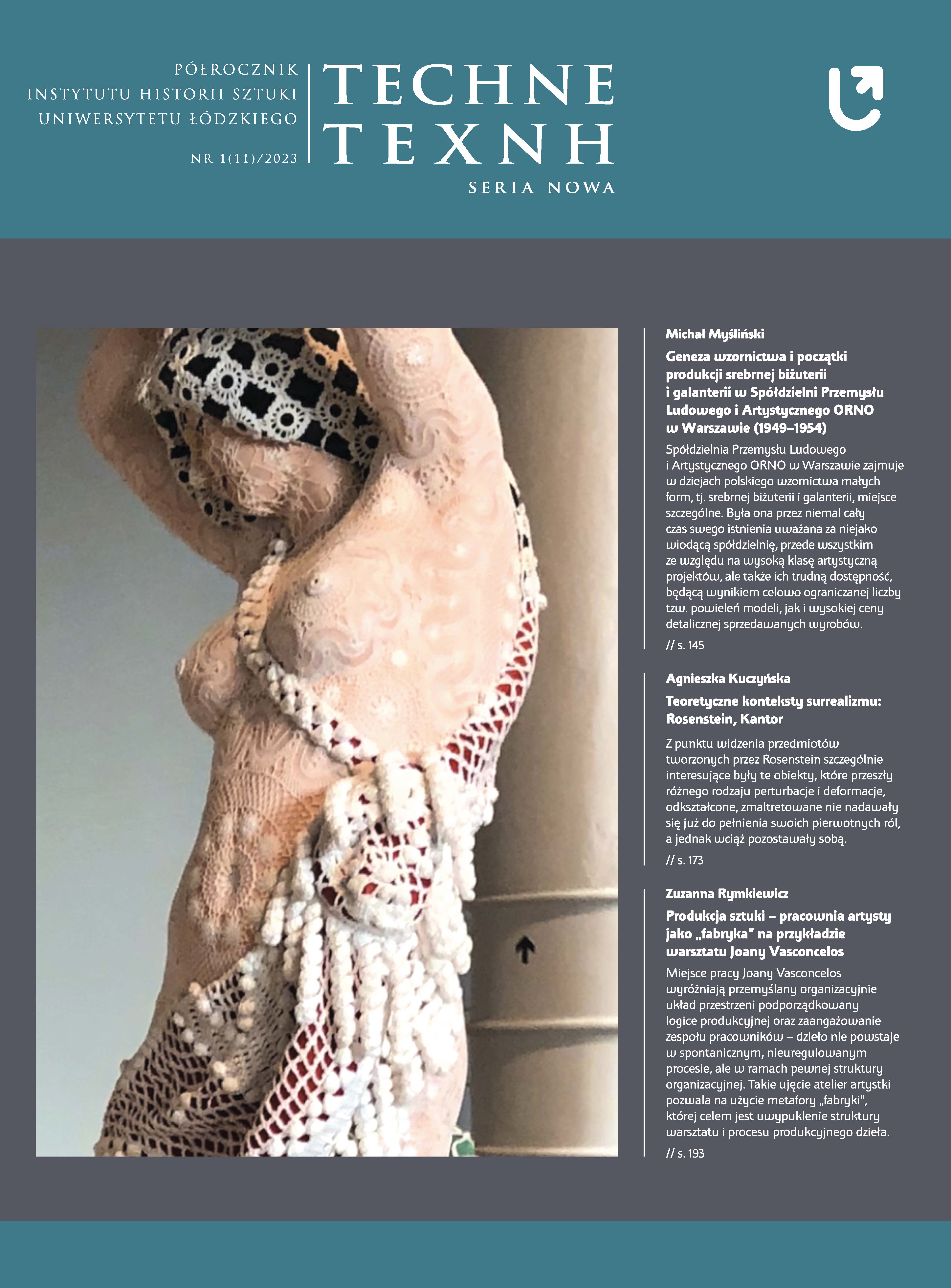Portrait before the invention of photography. Tadeusz Kościuszko’s physionotrace
DOI:
https://doi.org/10.18778/2084-851X.15.02Keywords:
iconography of Tadeusz Kościuszko, silhouette portraits, physionotraceAbstract
The engraving with the portrait of Tadeusz Kościuszko with a raised saber was one of the most popular images of the Chief from the moment of its creation in 1794 throughout the 19th century, most often copied and travested. Despite its popularity, the portrait has not been the subject of detailed research and has not received a separate study. It was only mentioned during anniversary exhibitions dedicated to Tadeusz Kościuszko and the 1794 Insurrection, when discussing the iconography of Tadeusz Kościuszko and propaganda prints related to the Insurrection.
Contrary to the information on the portrait about Quenedey’s authorship (the information concerns Edmé Quenedey 1756–1830) and Delanaux’s engraving, the portrait was associated with the name of Gilles Louis Chrétien (1754–1811). This ambiguity of authorship meant that in the literature on the subject, this portrait which was the prototype for dozens of portraits of Kościuszko with a raised sabre, is referred to as the “Chrétien type” or the “Quenedey type”.
The information left on the graphic portrait shows that it was made “mechanically”, using a device called “phisionotrace”. In fact, the engraving was made using the etching technique. The original image of Tadeusz Kościuszko made with physiotrace is not known. It has probably not survived to this day.
References
BÓBR 2000 – Maciej Bóbr, Mistrzowie grafiki europejskiej od XV do XVIII wieku, Warszawa 2000.
Google Scholar
CHODZKO 1859 – Loenard Chodzko, Usque ad finem. Żywoty narodowe z ostatnich lat. Tadeusz Kościuszko, Paryż 1859, http://www.wbc.poznan.pl/dlibra/applet?mimetype=image%2Fx.djvu&sec=false&handler=djvu_html5&content_url=%2FContent%2F3602%2FZywoty_21193-1.djvu&p=9 [dostęp: 10.08.2022].
Google Scholar
COURGOIN 1923 – François Courgoin, La gravure en France, des origines a 1900, Paris 1923.
Google Scholar
CYGANOWSKA 1975 – Roma Cyganowska, Ulotka i portret z szablą. Przyczynek do legendy kościuszkowskiej, „Rocznik Krakowski” 1975, t. 46, s. 56–57.
Google Scholar
GITELMAN, PINGREE 2003 – Lisa Gitelman, Geoffrey B. Pingree, New Media 1740–1915, London 2003.
Google Scholar
DOI: https://doi.org/10.7551/mitpress/5001.001.0001
GUMOWSKI 1917 – Marian Gumowski, Portrety Kościuszki. Studia ikonograficzne do dziejów polskich, t. I, Lwów 1917.
Google Scholar
HALLIDAY 1999 – Tony Halliday, Facing the public. Portraiture in the aftermath of the French Revolution, Manchester–New York 1999.
Google Scholar
HARPER [b.d.] – Douglas Harper, Photograph, [w:] Online Etymology Dictionary, https://www.etymonline.com/word/photograph [dostęp: 4.12.2022].
Google Scholar
HENNEQUIN 1932 – René Hennequin, Les portraits au physionotrace. Catalogue des 1800 premiers portraits de ce genre (cotés de „1” á „R 27”), Troyes 1932.
Google Scholar
JEFFARES [b.d.] – Neil Jeffares, Dictionary of Pastellist before 1800, [online], http://www.pastellists.com/Articles/Quenedey.pdf [dostęp: 11.11.2022].
Google Scholar
Klasyfikator umiejętności [b.d.] – Klasyfikator umiejętności, Forum Akademickie, https://forumakademickie.pl/fa-archiwum/archiwum/98/4/artykuly/21-gwiazdy.htm [dostęp: 30.08.2022].
Google Scholar
Kraków 1946 – Katalog wystawy historycznej 1746. Tadeusz Kościuszko. Obrazy – Pamiątki – Dokumenty w Muzeum Narodowym w Krakowie, Kraków 1946.
Google Scholar
Kraków 1984 – Katalog, Muzeum Narodowe w Krakowie, Kraków 1984.
Google Scholar
LETKIEWICZ 2010 – Ewa Letkiewicz, Silhouette – XVIII-wieczny portret sylwetowy i źródła jego powstania, „Annales Universitatis Mariae Curie-Skłodowska” 2010, t. VIII, nr 1.
Google Scholar
Lwów 1917 – Katalog wystawy urządzonej ku czci Tadeusza Kościuszki w setną rocznicę jego zgonu we Lwowie 15 października 1917 roku, Lwów 1917.
Google Scholar
MAZEAU 2012– Guillaume Mazeau, Portraits de peu. Le physionotrace au début du XIXᵉ siècle, „Revue d’histoire du XIXᵉ siècle” 2012, nr 45, s. 35.
Google Scholar
DOI: https://doi.org/10.4000/rh19.4334
MCKECHNIE 1978 – Sue McKechnie, British Silhouette Artists and their Work 1760–1860, Sotheby Parke Bernet 1978.
Google Scholar
MICHALCZYK 2010 – Zbigniew Michalczyk, Wczesna ikonografia Tadeusza Kościuszki i jej społeczny kontekst w Krakowie przełomu XVIII i XIX wieku, [w:] Socialinių tapatumų reprezentacijos Lietuvos Didžiosios Kunigaikštystės kultūroje, red. Paliušytė Aistė, Jankevičiūtė Giedrė, Vilinus 2010, s. 507–537.
Google Scholar
OKOŃ 1996a – Waldemar Okoń, Ikonografia Tadeusza Kościuszki. Wybrane zagadnienia, [w:] Powstanie kościuszkowskie i jego Naczelnik. Historia i Tradycja. Materiały konferencji naukowej Kraków–Wrocław, 28–30 marca 1994, red. Teresa Kulak, Mirosław Frančic, Warszawa 1996, s. 205–223.
Google Scholar
OKOŃ 1996b – Waldemar Okoń, Ikonografia Tadeusza Kościuszki. Wybrane zagadnienia, [w:] Wtajemniczenia. Studia z dziejów sztuki XIX i XX wieku, Wrocław 1996, s. 8–21.
Google Scholar
PAŚ 2011 – Monika Paś, Rękawiczki z portretem Kościuszki w zbiorach Muzeum Narodowego w Krakowie, „Kwartalnik Historii Kultury Materialnej” 2011, t. 59, nr 2, s. 217–224.
Google Scholar
PETERSON 2008 – Stephen Peterson, Niépce, Joseph Nicéphore, [w:] Encyclopedia of nineteenth-century photography, red. John Hannavy, New York 2008, s. 1003–1006, http://phsc.ca/camera/wp-content/uploads/2019/07/Encyclopedia-of-19th-Century-Photography.pdf [dostęp: 4.12.2022].
Google Scholar
SHOOK 2013 – John R. Shook, Fotografia. Joseph-Nicéphore Niépce, [w:] 1001 idei, które zmieniły nasz sposób myślenia, red. Robert Arp, Arthur Caplan, Poznań 2013, s. 463.
Google Scholar
Urządzenie Lavatiera [b.d.] – Urządzenie Lavatiera, zdjęcie, Wikipedia, https://en.wikipedia.org/wiki/Silhouette [dostęp: 15.11.2022].
Google Scholar
WEYNANT [b.d.] – Thomas Weynant, Early Visual Media. Precursors of Photography: The Physionotrace Portraits, Camera Obscura, Camera Lucida. Silhouette, Phisionotrace, Photogenic Drawing, http://users.telenet.be/thomasweynants/precursors.html[dostęp: 1.12.2022].
Google Scholar
WIDACKA 1994 – Hanna Widacka, Portrety Tadeusza Kościuszki w grafice XVIII wieku, Warszawa 1994.
Google Scholar
WIDACKA 1997 – Hanna Widacka, Grafika polska czasów insurekcji, [w:] Kościuszko – powstanie 1794 – tradycja. Materiały z sesji naukowej w 200-lecie powstania kościuszkowskiego, 15–16 kwietnia 1994, red. Jerzy Kowecki, Warszawa 1997, s. 227–240.
Google Scholar
WILAMOWSKI/WNĘK/ZYBLIKIEWICZ 1998 – Maciej Wilamowski, Konrad Wnęk, Lidia A. Zyblikiewicz, Leksykon polskich powiedzeń historycznych, Kraków 1998.
Google Scholar
WOLTANOWSKI 1997 – Andrzej Woltanowski, Kult Tadeusza Kościuszki w grafice warszawskiej 1794, [w:] Kościuszko – powstanie 1794 – tradycja. Materiały z sesji naukowej w 200-lecie powstania kościuszkowskiego, 15–16 kwietnia 1994, red. Jerzy Kowecki, Warszawa 1997, s. 241–267.
Google Scholar
„Journal de Paris”, nr 203 – „Journal de Paris”, nr 203, 21 Juillet 1788, s. 887, https://babel.hathitrust.org/cgi/pt?id=hvd.hxk2m2&view=1up&seq=89 [dostęp: 12.11.2022].
Google Scholar
„Journal de Paris”, nr 207 – „Journal de Paris”, nr 207, 25 Juin 1788, https://babel.hathitrust.org/cgi/pt?id=hvd.hxk2m1 [dostęp: 10.10.2022].
Google Scholar
Downloads
Published
How to Cite
Issue
Section
License

This work is licensed under a Creative Commons Attribution-NonCommercial-NoDerivatives 4.0 International License.








